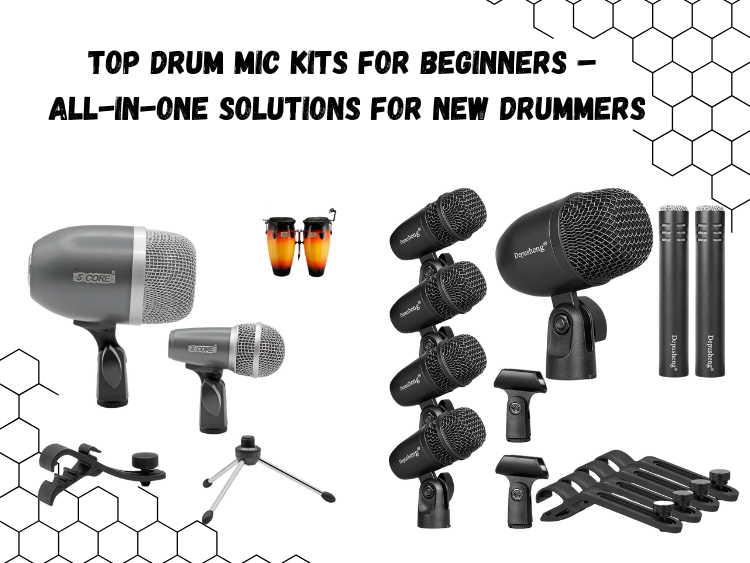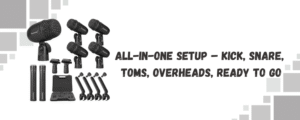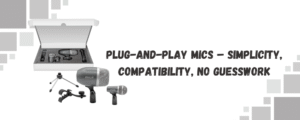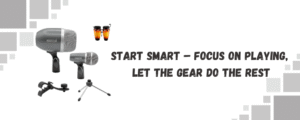Starting out as a drummer is tough enough. You’re juggling timing, technique, maybe even soundproofing. The last thing you need is to get buried in the chaos of mic choices, XLR cables, and preamp talk. You just want to record your kit cleanly—without burning through your savings.
That’s where a good drum mic kit comes in. All-in-one sets simplify everything. You get the right number of mics, matched for different drums, often with clips and cases included. No guesswork, no mismatched gear. If you’re setting up a basic home studio or want to start recording yourself without constantly tweaking knobs, you’re in the right place.
Let’s break down what actually matters when picking your first drum mic kit—and why some choices make your life easier from day one.
Why All-in-One Drum Mic Kits Work So Well for Beginners
The biggest win? Simplicity.
When you’re new, diving into individual mic specs—SPL handling, polar patterns, EQ curves—can feel like a rabbit hole. With a kit, someone’s already done the work. You get a set of mics pre-configured to handle kick, snare, and toms, often with extra condensers for overheads or cymbals.
More importantly, all mics in a kit are designed to work together tonally. That means less fiddling in your DAW, fewer phase issues, and a much smoother mix. You can focus on your playing and basic mic placement instead of endless troubleshooting.
What to Look For in a Beginner Mic Kit
- Kick Drum Coverage
You’ll want a mic with a large diaphragm and high SPL handling to deal with the low-end thump. It should capture the punch of your beater without getting muddy. - Snare & Tom Mics
Cardioid dynamic mics are ideal here—they reject bleed and give you that close, controlled sound. Mountable clips are a huge bonus, especially if you’re short on stands. - Overhead or Cymbal Mics
These are often condensers, and while not every beginner kit includes them, having a pair can completely lift your recordings. They catch the shimmer, space, and natural decay your close mics won’t. - Mounting Hardware
Good clips matter more than you think. Cheap ones break. Flimsy ones slip. Solid mic clips that attach to the drum rim will make your sessions smoother.
One Kit That Gets It Right from the Start
If you want a true plug-and-play solution, the 5 Core Conga Mic Snare Tom Microphone Drum Kit is the kind of setup that hits the mark for new drummers.
Here’s why:
- Tailored for drums – Each mic is designed with percussion in mind, from punchy toms to tight snares.
- Condenser and dynamic blend – You get a combination of mics that can handle both crisp transients and powerful low-end hits.
- XLR-ready – No adapters needed. Just plug into your interface or mixer and go.
- Built tough – These aren’t disposable mics. They’re built to take a bit of rough handling—because let’s face it, setting up and tearing down gets messy sometimes.
If you’re looking for more options, this Depusheng 7-Piece Drum Microphone Set also highlights some budget-friendly bundles that don’t skimp on essentials.
How Many Mics Do You Really Need?
Short answer: Depends on your setup.
If you’re running a 4-piece or 5-piece kit, a 5–7 mic setup is more than enough. You’ll want a kick mic, one for the snare, and one each for the toms. Overheads can be added if you want more air in the mix.
If you’re tight on space or gear, start with fewer mics—but get better placement. A good kick and snare mic alone can take you surprisingly far if you set them right.
Final Thought: Gear Helps, but Ears Matter More
Even with the best beginner mic kit, your sound won’t lock in unless you listen critically. Placement matters. Room treatment helps. And how you tune your drums? Game-changer.
That said, getting a quality, beginner-friendly mic kit removes half the stress. You stop worrying about gear and start focusing on what actually counts—playing tighter, recording smarter, and capturing your sound with confidence.




